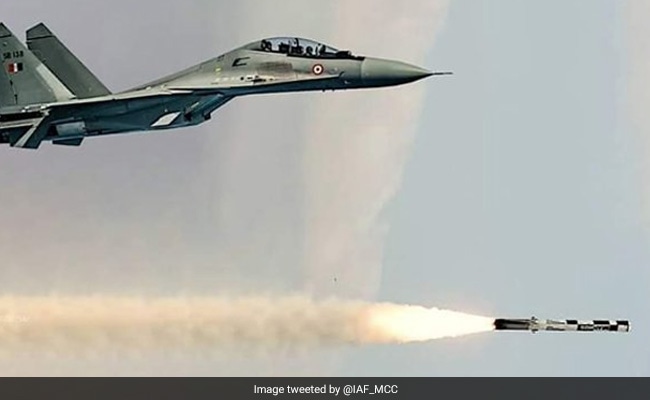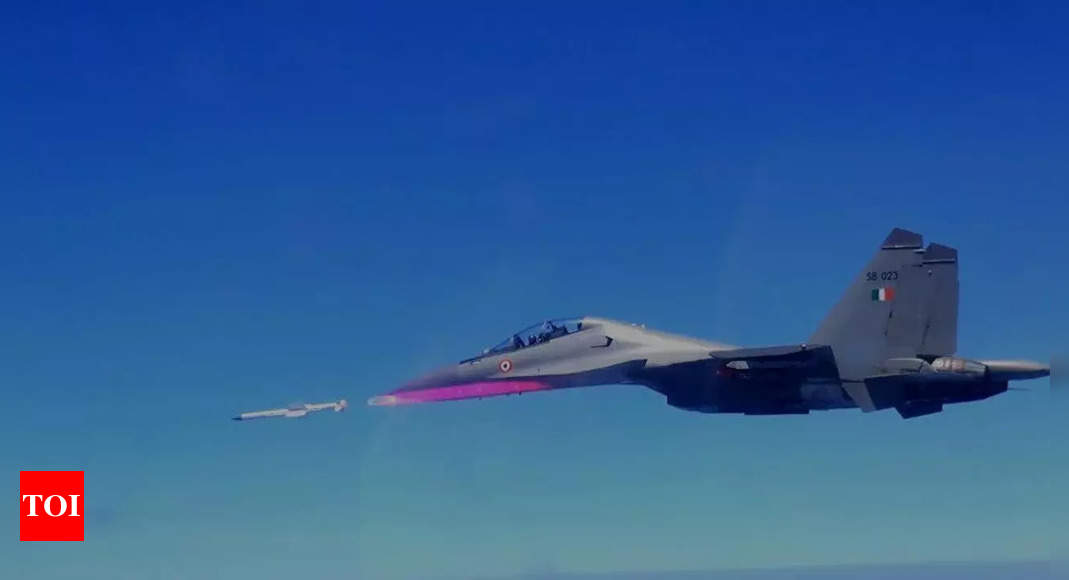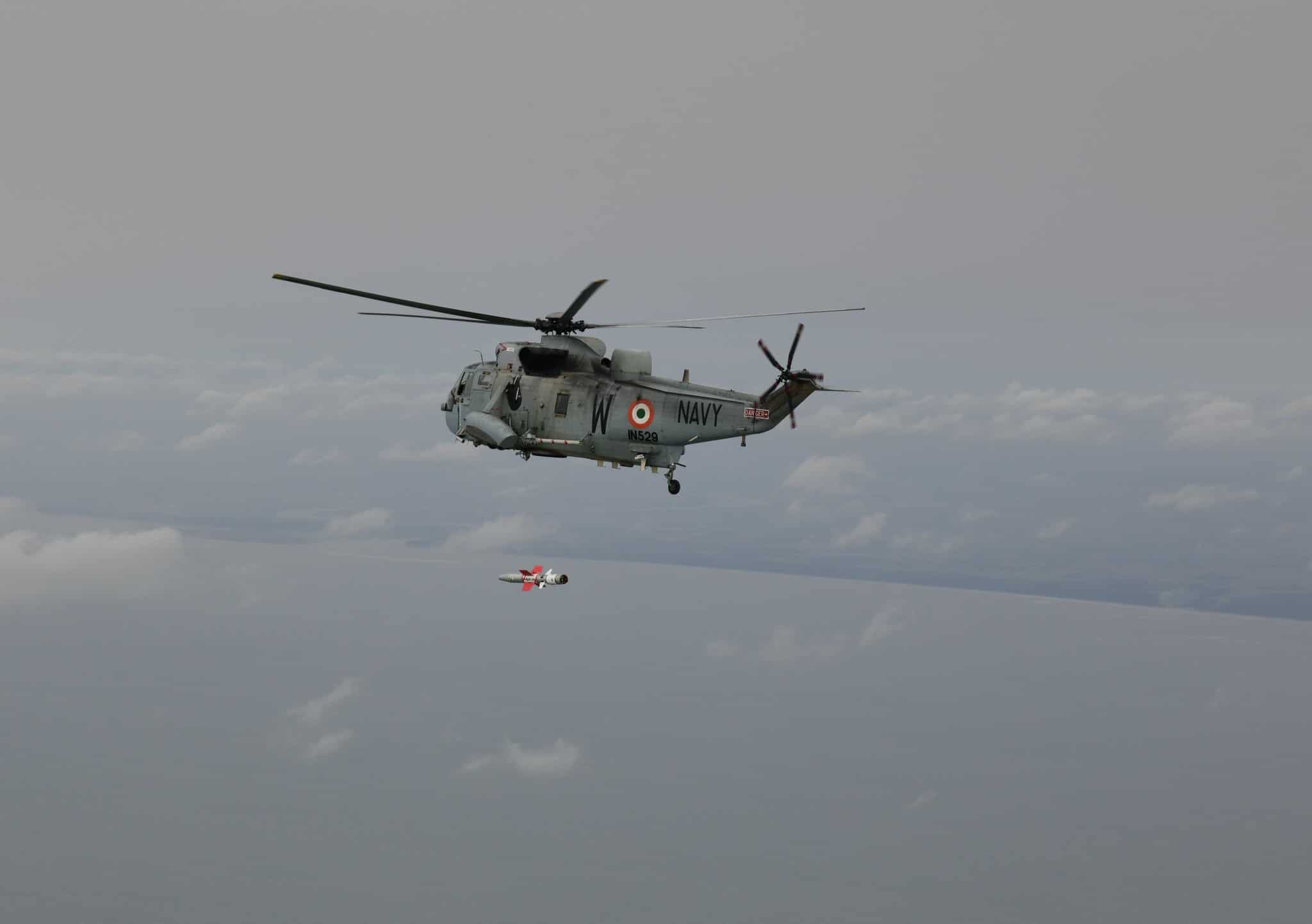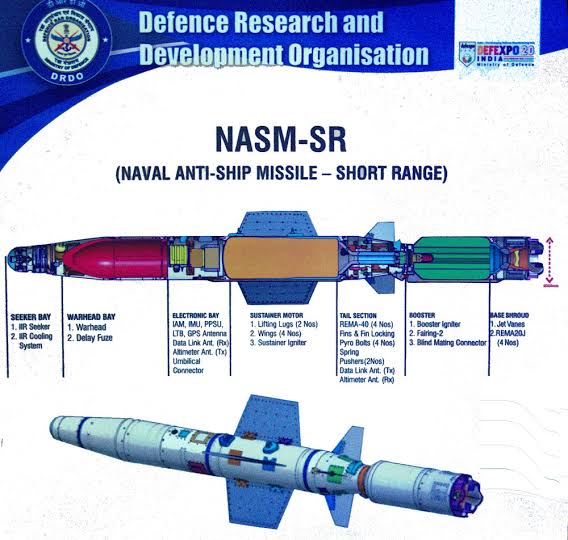Latest Thread
You are using an out of date browser. It may not display this or other websites correctly.
You should upgrade or use an alternative browser.
You should upgrade or use an alternative browser.
Two way data link

"Direct Hit": Indian Air Force Successfully Test Fires BrahMos Missile From Sukhoi-30 Jet
In demonstrating its operational preparedness, the Indian Air Force (IAF) on Tuesday successfully test-fired a BrahMos supersonic cruise missile from a Sukhoi fighter jet on the Eastern seaboard.
The "live firing" of the missile was carried out in close coordination with the Indian Navy.
New Delhi:
In demonstrating its operational preparedness, the Indian Air Force (IAF) on Tuesday successfully test-fired a BrahMos supersonic cruise missile from a Sukhoi fighter jet on the Eastern seaboard.
The "live firing" of the missile was carried out in close coordination with the Indian Navy, the IAF said.
The missile hit the target with accuracy and precision, officials said.
"Today on the Eastern seaboard, #IAF undertook live firing of #BrahMos missile from a Su30 MkI aircraft. The missile achieved a direct hit on the target, a decommissioned #IndianNavy ship. The mission was undertaken in close coordination with @indiannavy," the IAF said in a tweet.
In 2016, the government had decided to integrate the air-launched variant of the Brahmos into over 40 Sukhoi fighter jets.
The project was conceived to enhance the IAF's capability to strike from large stand-off ranges on any target on sea or land.
On March 5, the Indian Navy successfully test-fired an advanced version of the Brahmos supersonic cruise missile from a stealth destroyer in the Indian Ocean.
The missile was test-fired from the stealth destroyer INS Chennai.
BrahMos Aerospace, an India-Russian joint venture, produces supersonic cruise missiles that can be launched from submarines, ships, aircraft, or land platforms.
BrahMos missile flies at a speed of 2.8 Mach or almost three times the speed of sound.
The range of the advanced version of the missile is learnt to have been extended to around 350 km from the original 290 km.
Comments(This story has not been edited by NDTV staff and is auto-generated from a syndicated feed.)

From missiles to glide bombs, India set to test several advanced weapon systems | India News - Times of India
India News: NEW DELHI: India is getting set to conduct a slew of tests of several indigenously-developed advanced weapons, ranging from air-to-air missiles and an.
NEW DELHI: India is getting set to conduct a slew of tests of several indigenously-developed advanced weapons, ranging from air-to-air missiles and anti-radiation missiles to smart anti-airfield weapons and long-range glide bombs.
The tests of at least three weapons, the Astra-1 (100-km range) and Astra-2 (160-km) beyond visual range air-to-air missiles (BVRAAMs) as well as the new generation anti-radiation missile (NGARM) Rudram-1 with a strike range of 150-km, are slated for this month, defence sources told TOI.
The Astra-2 will undergo its “first live launch” from a Sukhoi-30MKI fighter after completion of its carriage and handling trials as well as “dummy drops”. The Astra-1, already under production by defence PSU Bharat Dynamics after the successful completion of its user trials, in turn will be tested for the first time with an indigenous seeker instead of the existing Russian AGAT one from a Sukhoi jet.
The IAF has already placed an initial order for 250 Astra-1 missiles, which flies over four times the speed of sound at Mach 4.5, to arm its Sukhoi fighters. The integration of Astra-1 with the Tejas and MiG-29 fighters is also concurrently underway.
DRDO is also planning to conduct the first test of Astra-3, based on the solid fuel-based ducted ramjet (SFDR) propulsion to enhance its range to 350-km, by the end of this year, the sources said.
The all-weather day and night capable Astra series of missiles, designed to detect, track and destroy highly-agile supersonic fighters packed with “counter-measures’’ at long ranges, will eventually replace the expensive Russian, French and Israeli BVRAAMs that are currently imported to arm IAF fighters.
Another test this month will be of the Rudram-1 NGARM that is designed to destroy a variety of enemy surveillance, communication and radar targets on the ground at a 150-km range after being fired from fighter jets.
DRDO is also developing Rudram-2 (350-km range) and Rudram-3 (550-km) air-to-ground missiles, which also have INS-GPS navigation with a passive homing head for the final attack.
“Trials of Rudram-2 should also begin soon. Rudram missiles are designed for suppression of enemy air defences (SEAD) from longer stand-off ranges to allow IAF strike aircraft to carry out their bombing missions without hindrance,” a source said.
Then, tests of smart anti-airfield weapons (SAAW), which are precision-guided bombs designed to destroy enemy runways, bunkers, aircraft hangers, radars and other reinforced structures at a range of 100-km, are also in the pipeline.
“These are 125-kg glide bombs, based on two configurations of either satellite navigation or electro-optical imaging infra-red seeker (EOIIR), carried on racks in fighters like Sukhois or Jaguars. A single Sukhoi can carry 32 such bombs. Separately, 1000-kg heavy calibre glide bombs, with a 80-km range, are also being developed,” he added.
Rajendra Chola
Well-known member

DRDO and Indian Navy Test-Fire New NASM-SR Missile - Naval News
India test-fired a new helicopter-launched anti-ship missile today. The missile is known as "Naval Anti-Ship Missile-Short Range" or NASM-SR.
 www.navalnews.com
www.navalnews.com

DRDO and Indian Navy Test-Fire New NASM-SR Missile - Naval News
India test-fired a new helicopter-launched anti-ship missile today. The missile is known as "Naval Anti-Ship Missile-Short Range" or NASM-SR.
India test-fired a new helicopter-launched anti-ship missile today. The missile is known as "Naval Anti-Ship Missile-Short Range" or NASM-SR.
Naval News Staff 18 May 2022Indian MoD press release
Defence Research and Development Organisation (DRDO) and Indian Navy successfully conducted maiden flight-test of indigenously-developed Naval Anti-Ship Missile launched from a Naval Helicopter from Integrated Test Range (ITR), Chandipur off the coast of Odisha on May 18, 2022. The mission met all its objectives. It is the first indigenous air launched anti-ship missile system for the Indian Navy.
The missile followed the desired sea skimming trajectory and reached the designated target with high degree of accuracy, validating the control, guidance and mission algorithms. All the sub-systems performed satisfactorily. The sensors deployed across the test range and near impact point tracked the missile trajectory and captured all the events.
The missile employed many new technologies, including an indigenously developed launcher for the helicopter. The missile guidance system includes state-of-the-art navigation system and integrated avionics. The flight test was witnessed by senior officers of DRDO and the Indian Navy.
Raksha Mantri Shri Rajnath Singh congratulated DRDO, Indian Navy and associated teams for the maiden developmental flight test. He said, India attained a high level of capability in the indigenous design and development of Missile systems.

Secretary Department of Defence R&D and Chairman DRDO Dr G Satheesh Reddy appreciated the efforts of the project team for successfully proving mission objectives. He complimented the Indian Navy and Naval Flight Test Squadron for their support to the project and said that the system will strengthen offensive capability of Indian Navy.
===============================================
Last edited by a moderator:
Rajendra Chola
Well-known member
Range of 5 to 55km. First in series of indigenous heli bourne anti ship missiles.
@Rajaraja Chola when starting new thread, please start it with news article first and then tweets etc after it.
I edited it for you just now to show what I mean.
Tweets only is fine, but then just use existing thread instead like gessler did before you:

I edited it for you just now to show what I mean.
Tweets only is fine, but then just use existing thread instead like gessler did before you:
Rajendra Chola
Well-known member
@Rajaraja Chola when starting new thread, please start it with news article first and then tweets etc after it.
I edited it for you just now to show what I mean.
Tweets only is fine, but then just use existing thread instead like gessler did before you:

Sure. You can merge it later. Just wanted to discuss the implications of this missile. Would potentially replace Harpoons (in longer term) and Sea eagle, kh35. Would also be an great selling point of Dhruv if they integrate it on them.
cicaklaut
Member
Small is beautiful as there are many many more small  to sink than big ones
to sink than big ones
fire starter
Well-known member
fire starter
Well-known member
Could you give a few descriptors what all the lines etc are pointing out?
AD2 missile . Self explanatory imageCould you give a few descriptors what all the lines etc are pointing out?





